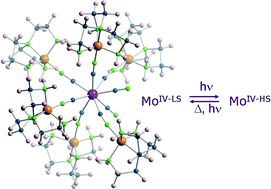 In this Dalton Transactions Hot Article, Maria-Angels Carvajal and colleagues probe the photomagnetic properties of a copper octacyanomolybdate complex using high level ab initio calculations.
In this Dalton Transactions Hot Article, Maria-Angels Carvajal and colleagues probe the photomagnetic properties of a copper octacyanomolybdate complex using high level ab initio calculations.
The authors describe in detail the photomagnetic process arising from a local Mo d-d excitation in the complex. They also show that there is a small energy barrier for the reverse reaction and that it can be induced by light. They also investigate the temperature dependence of the magnetic susceptibility and compare it with experimental values.
Photomagnetic materials are of interest as candidates for use in memory devices and optical switches.
Read more for FREE until Tuesday 12th July:
Insights on the photomagnetism in copper octacyanomolybdates
Maria-Angels Carvajal, Rosa Caballol and Coen de Graaf
Dalton Trans., 2011, Advance Article
DOI: 10.1039/C1DT10120J, Paper











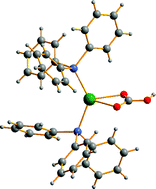
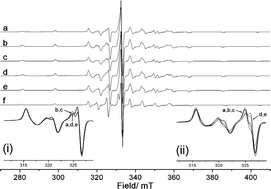 In this HOT article, the authors have extended their work in understanding enantioselective catalysis by coordination compounds. The role of steric hindrance in controlling the binding mode of propylene oxide to a novel vanadyl salen-type complex N,N‘-bis(5-tert-butylsalicylidene)-1,2-cyclohexanediamino-vanadium(IV) oxide, [VO(3)], has been investigated using CW/pulse EPR, ENDOR and HYSCORE spectroscopy and compared to that of the parent complex N,N‘-bis(3,5-di-tert-butylsalicylidene)-1,2-cyclohexanediamino-vanadium(IV) oxide, [VO(1)]. Removal of the ‘inner tert-butyl groups from the salicylidene rings reduces the steric hindrance between the ligand and epoxide substrate. As a result the selectivity for binding single enantiomers of propylene oxide in these complexes is reversed in [VO(3)] relative to [VO(1)].
In this HOT article, the authors have extended their work in understanding enantioselective catalysis by coordination compounds. The role of steric hindrance in controlling the binding mode of propylene oxide to a novel vanadyl salen-type complex N,N‘-bis(5-tert-butylsalicylidene)-1,2-cyclohexanediamino-vanadium(IV) oxide, [VO(3)], has been investigated using CW/pulse EPR, ENDOR and HYSCORE spectroscopy and compared to that of the parent complex N,N‘-bis(3,5-di-tert-butylsalicylidene)-1,2-cyclohexanediamino-vanadium(IV) oxide, [VO(1)]. Removal of the ‘inner tert-butyl groups from the salicylidene rings reduces the steric hindrance between the ligand and epoxide substrate. As a result the selectivity for binding single enantiomers of propylene oxide in these complexes is reversed in [VO(3)] relative to [VO(1)]. In this HOT article, the molecular structures of 1,2-closo-P2B10H10 (1) and 1,2-closo-As2B10H10 (2) have been determined by gas electron diffraction and the results obtained compared with those from computation at the MP2/6-31G** level of theory. The first examples of metalladiphosphaboranes and a considerable extension of the range of known metalladiarsaboranes, these compounds being prepared from deboronated derivatives of 1 and 2, respectively, are also reported.
In this HOT article, the molecular structures of 1,2-closo-P2B10H10 (1) and 1,2-closo-As2B10H10 (2) have been determined by gas electron diffraction and the results obtained compared with those from computation at the MP2/6-31G** level of theory. The first examples of metalladiphosphaboranes and a considerable extension of the range of known metalladiarsaboranes, these compounds being prepared from deboronated derivatives of 1 and 2, respectively, are also reported. A N^N Pt(II) bis(acetylide) complex containing coumarin was prepared in this Dalton Transactions Hot article.
A N^N Pt(II) bis(acetylide) complex containing coumarin was prepared in this Dalton Transactions Hot article.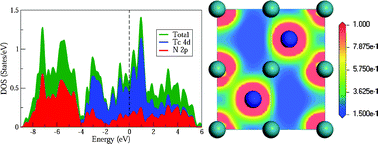 The most stable crystal structures of different TCN compounds are investigated in this Dalton Transactions Hot article.
The most stable crystal structures of different TCN compounds are investigated in this Dalton Transactions Hot article.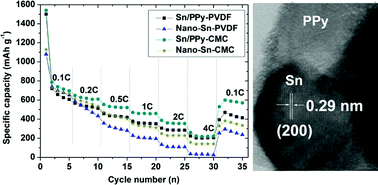 Rechargeable lithium-ion batteries (LIBs) have successfully dominated the commercial power supply market for advanced portable electronics. In this regard, metallic Sn has attracted a great deal of interest as an anode material because of its high theoretical capacity offering a significant advantage over the currently used graphite but until now has not been utilized due to the huge volumetric changes during Li-insertion/extraction cycling, which leads to rapid pulverization and poor cyclability of the materials.
Rechargeable lithium-ion batteries (LIBs) have successfully dominated the commercial power supply market for advanced portable electronics. In this regard, metallic Sn has attracted a great deal of interest as an anode material because of its high theoretical capacity offering a significant advantage over the currently used graphite but until now has not been utilized due to the huge volumetric changes during Li-insertion/extraction cycling, which leads to rapid pulverization and poor cyclability of the materials. 
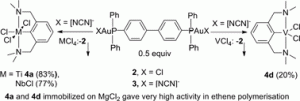
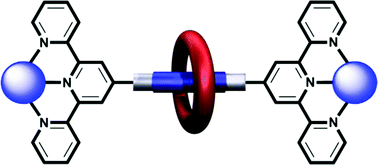
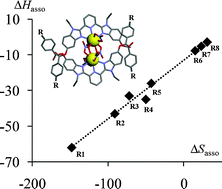 This Perspective article by Claude Piguet has been selected as a Dalton Transactions Hot article, where the current understanding of the role of energy in self assembly is explained.
This Perspective article by Claude Piguet has been selected as a Dalton Transactions Hot article, where the current understanding of the role of energy in self assembly is explained.